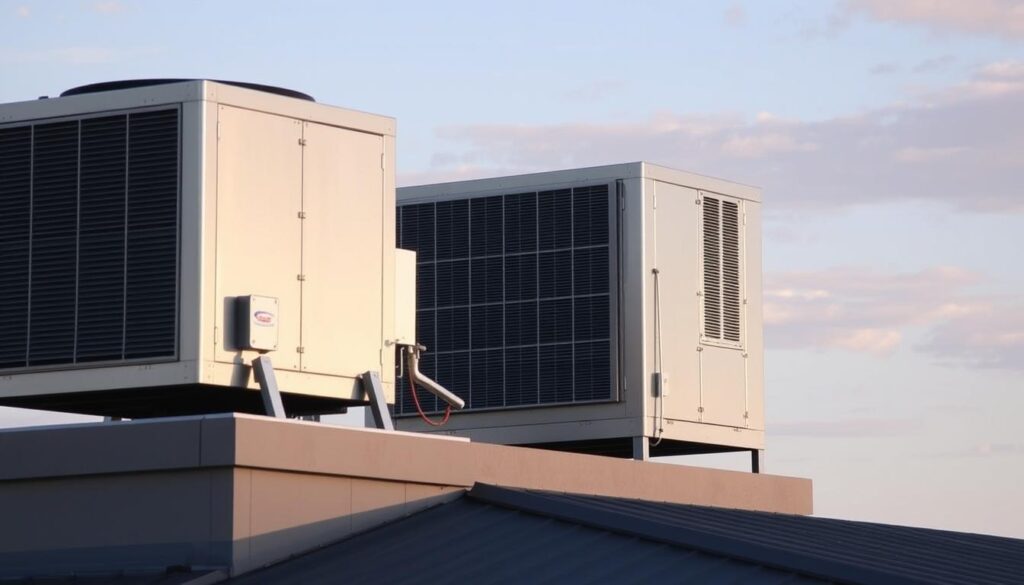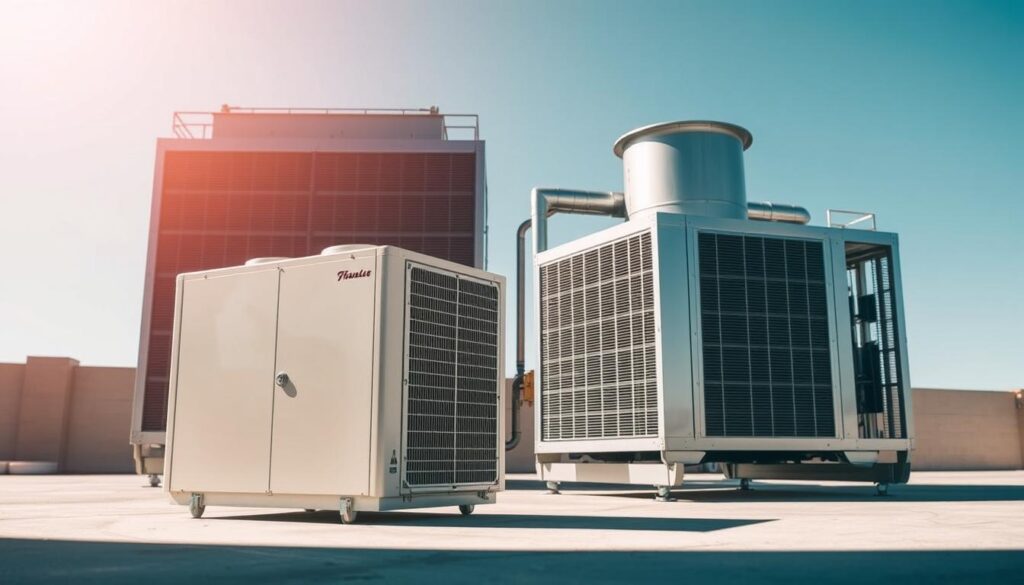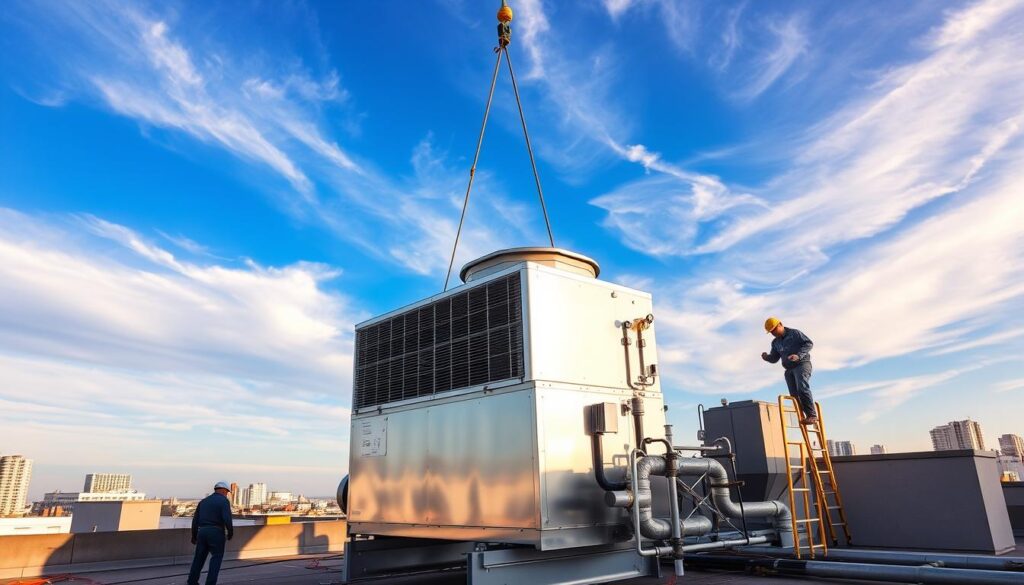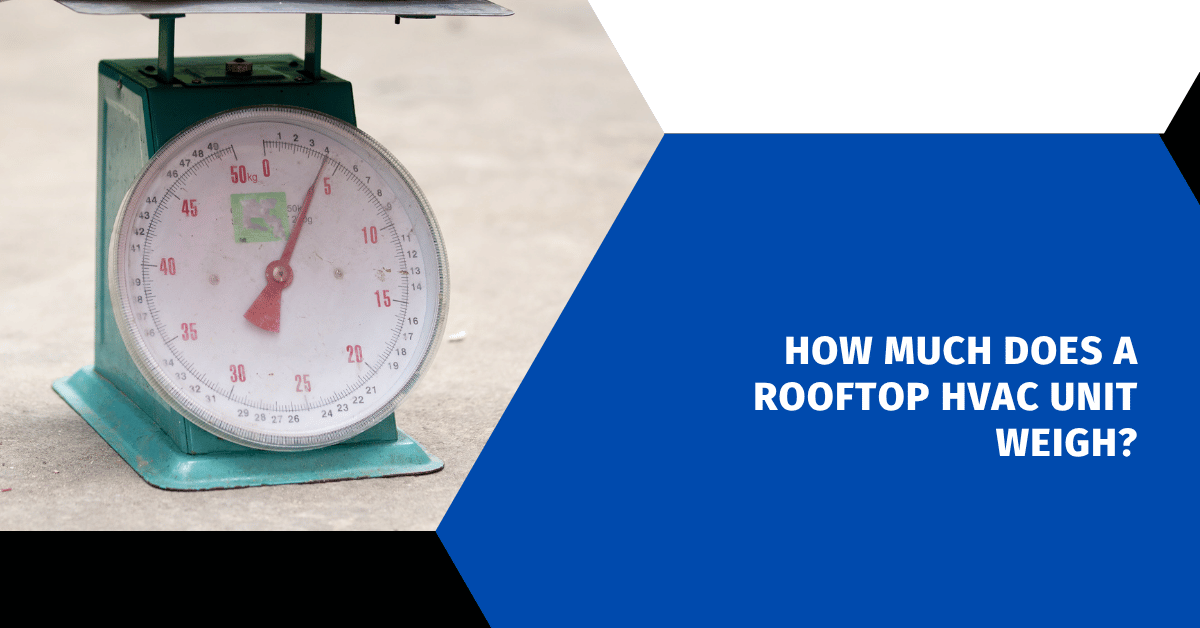How Much Does a Rooftop HVAC Unit Weigh? Ever thought about what it takes to hold up a huge rooftop HVAC unit? It keeps the whole building’s climate just right. Knowing how much it weighs is really important.

Figuring out how much a rooftop HVAC unit weighs is a big challenge. It can weigh a lot, affecting the building’s strength and how much it costs to install.
The weight of a rooftop HVAC unit is more than just a number. It’s key to building design, safety, and how well it works. Experts must think carefully about weight to make sure it’s supported right.
Key Takeaways
- Rooftop HVAC unit weight varies significantly based on size and configuration
- Building structural capacity is directly impacted by unit weight
- Weight considerations affect installation complexity and costs
- Different building types require unique weight management strategies
- Manufacturers design units with weight optimization in mind
Table of Contents
Understanding Rooftop HVAC Unit Weight Basics
When looking at a detailed hvac unit weight guide, it’s key to know what makes up the weight of rooftop units. These units have many parts that affect their weight and how well they work.
Key Weight Components
The main parts that add to the weight of rooftop HVAC units are:
- Compressors (heaviest single component)
- Heat exchangers
- Blower assemblies
- Electrical control systems
- Outer casing and structural framework
Impact of Unit Size on Weight
The size of your HVAC unit affects its weight. Larger units for bigger commercial spaces are heavier. The weight can change a lot based on how much cooling it needs.
| Unit Size | Cooling Capacity | Approximate Weight |
|---|---|---|
| Small | 2-5 tons | 300-500 lbs |
| Medium | 5-10 tons | 500-800 lbs |
| Large | 10-20 tons | 800-1500 lbs |
Material Construction Factors
Choosing the right materials is important for the weight of the unit. Using lighter materials like aluminum can make the unit lighter but costlier. Steel is often used for its strength and durability.
The balance between weight, performance, and cost drives material selection in modern HVAC unit design.
Average Weight Ranges for Commercial Rooftop Units
Knowing the commercial HVAC weight is key when picking a rooftop unit for your building. Heavy rooftop units vary in size and weight. This depends on their cooling power and design needs.
Rooftop HVAC units range from light 3-ton models to big 50-ton systems. Their weight changes based on several important factors:
- Cooling capacity
- Number of components
- Material construction
- Additional features
Here’s a look at typical weight ranges for commercial HVAC systems:
| Unit Size | Weight Range | Typical Application |
|---|---|---|
| 3-5 ton units | 500-1,200 lbs | Small offices, retail spaces |
| 10-15 ton units | 1,500-3,000 lbs | Medium commercial buildings |
| 25-50 ton units | 3,500-7,000 lbs | Large commercial complexes |
When planning HVAC installation, think about your building’s structure. Larger units need stronger support systems for safe and effective use. Always talk to a professional HVAC engineer to find the right unit for your needs.
The actual weight can change based on the manufacturer’s design and extra features. This includes energy-saving features or special cooling tech.
Explore Our HVAC Shop
Looking for top-rated HVAC tools, parts, and accessories? Visit our shop and find the perfect solution for your needs.
Visit the ShopFactors Affecting Rooftop HVAC Unit Weight
Knowing what affects rooftop HVAC unit weight helps you choose the best for your building. Several important factors decide how heavy these cooling systems are.
Rooftop HVAC unit weight changes a lot based on several key things. Engineers and facility managers need to think about these carefully.
Cooling Capacity Impact
The cooling power of a rooftop HVAC unit affects its weight. Bigger systems for large commercial areas need more parts. This makes them heavier.
- Small units (1-5 tons): Typically lighter, around 300-700 pounds
- Medium units (5-10 tons): Weight ranges from 700-1,500 pounds
- Large units (10-20 tons): Can weigh between 1,500-3,000 pounds
Manufacturing Materials
Lightweight rooftop HVAC systems use new materials to cut down on weight. Aluminum and composite materials are much lighter than steel.
- Aluminum: Reduces unit weight by 30-40%
- Composite materials: Provide durability with minimal weight increase
- Steel: Heavier but offers maximum structural integrity
Additional Components
Features like economizers, advanced filters, and heat recovery modules add to the weight. These parts boost performance but make the system heavier.
Selecting the right balance between functionality and weight is key for the best HVAC system performance.
Explore Our HVAC Shop
Looking for top-rated HVAC tools, parts, and accessories? Visit our shop and find the perfect solution for your needs.
Visit the ShopHow Much Does a Rooftop HVAC Unit Weigh?
Knowing the weight of a rooftop HVAC unit is key for safe installation and building support. The weight changes a lot based on several important factors. You’ll see a big range of weights for different types and sizes of units.
Rooftop HVAC units can weigh from 200 to 5,000 pounds. The weight guide shows different ranges for different types:
- Residential units: 200-800 pounds
- Small commercial units: 800-2,500 pounds
- Large commercial systems: 2,500-5,000 pounds
Several things affect the weight of a rooftop HVAC unit:
- Cooling capacity
- Size of the unit
- Materials used in construction
- Additional components and accessories
Experts say to always check the manufacturer’s specs. Each model has its own weight, which affects how it’s installed. It’s important to make sure your building can handle the weight of the HVAC unit.
Precise weight measurements are essential for safe and effective rooftop HVAC installation.
When planning your HVAC installation, talk to a pro who knows the exact weight of your unit. This helps pick the right system for your building’s strength.
Structural Requirements for Rooftop HVAC Installation
Putting a rooftop HVAC unit in place requires more than just picking a spot. Your roof must be strong enough to handle the weight and complexity of today’s HVAC systems. Knowing the weight needs for rooftop HVAC is key to avoiding damage and keeping your system running well.
Getting the roof load right is essential for a safe rooftop HVAC setup. Experts use special methods to check if your roof can handle the load. They look at how much weight it can bear and any challenges.
Building Code Compliance
Local building codes have rules for putting HVAC on rooftops. These rules help keep everyone safe and make sure the roof stays strong. They cover things like:
- Minimum load-bearing requirements
- Specific mounting techniques
- Required structural reinforcements
- Professional engineering assessments
Load Distribution Requirements
Spreading the weight right helps avoid damage to your roof. It’s about:
- Placing the unit carefully
- Using strong mounting platforms
- Evenly distributing the weight
- Adding extra support when needed
Safety Margins
Installers often add extra safety measures that go beyond the minimum. This makes your roof even stronger and safer. It helps against unexpected loads and keeps your system working well for a long time.
- Extra structural resilience
- Protection against unexpected loads
- Long-term performance assurance
- Compliance with advanced engineering standards
Proper structural assessment is not an expense—it’s an investment in your building’s longevity and safety.
By checking the weight needs for rooftop HVAC and doing detailed load calculations, you can get a safe, efficient, and lasting HVAC system.
Explore Our HVAC Shop
Looking for top-rated HVAC tools, parts, and accessories? Visit our shop and find the perfect solution for your needs.
Visit the ShopLightweight vs Heavy-Duty Rooftop Units

Choosing between lightweight rooftop hvac systems and heavy rooftop units depends on your building’s specific needs. Each type has its own benefits that can greatly affect your HVAC performance and installation costs.
Lightweight rooftop hvac systems have several advantages for buildings with structural limits:
- Reduced structural stress
- Easier installation process
- Lower transportation expenses
- Improved energy efficiency
Heavy rooftop units are best for demanding environments where durability matters. They offer strong performance for industrial and commercial needs that need intense cooling.
When deciding between lightweight and heavy-duty units, consider:
- Building structural capacity
- Climate conditions
- Cooling requirements
- Budget constraints
Professional HVAC designers suggest carefully evaluating your needs before choosing a rooftop unit. Talking to an experienced professional can help you pick the best option for your facility.
The right HVAC system balances performance, efficiency, and structural compatibility.
Weight Considerations for Different Building Types
Choosing the right commercial HVAC weight is key for your building’s performance and safety. Each building type has its own needs that affect how much weight a rooftop HVAC system can handle.
Knowing the weight challenges helps owners and managers pick the best HVAC system for their buildings.
Commercial Buildings: Precision and Balance
Commercial buildings need a careful look at HVAC unit weight. You should consider:
- Roof load capacity limitations
- Structural support requirements
- Energy efficiency goals
Industrial Facilities: Heavy-Duty Solutions
Industrial spaces need strong HVAC systems with higher weights. They must handle:
- Extreme temperature changes
- Constant use
- Tough environmental conditions
Retail Structures: Flexibility and Aesthetics
Retail buildings have special needs for rooftop HVAC systems. Designers must think about:
| Consideration | Impact |
|---|---|
| Visual Appeal | Minimal visible equipment |
| Space Efficiency | Compact, lightweight units |
| Noise Reduction | Strategic unit placement |
Your HVAC system choice should match your building’s structure and needs.
Explore Our HVAC Shop
Looking for top-rated HVAC tools, parts, and accessories? Visit our shop and find the perfect solution for your needs.
Visit the ShopTransportation and Installation Weight Challenges
Transporting and installing rooftop HVAC units is a big job. It needs careful planning and the right tools. The weight of the unit is a key factor in how hard it is to install.
When you’re moving heavy HVAC systems, think about a few important things:
- Specialized lifting equipment requirements
- Roof structural capacity
- Access limitations
- Urban environment constraints
Your guide on HVAC unit weight must tackle many transport challenges. Big commercial units can be 500 to 2,000 pounds. This means you’ll need expert moving plans.
| Unit Size | Average Weight | Transportation Complexity |
|---|---|---|
| Small Commercial | 500-800 lbs | Low |
| Medium Commercial | 800-1,500 lbs | Medium |
| Large Commercial | 1,500-2,000 lbs | High |
Teams of pros use cranes or special rigging to handle heavy units. You’ll need to plan for road closures, crane setup, and exact routes for safe transport.
Important things to remember include:
- Verifying crane access points
- Checking building structural integrity
- Obtaining necessary permits
- Coordinating with local traffic management
Safety and precision are key when moving and installing rooftop HVAC units.
Impact of Unit Weight on Installation Costs
Rooftop HVAC installation weight is key to project costs. The weight of commercial HVAC units affects many parts of the installation. This makes it vital for building managers and contractors to think about it.

When planning a rooftop HVAC unit installation, several factors related to unit weight come into play:
Crane Requirements
Heavier commercial HVAC units need special crane services. The weight of the unit can greatly affect crane rental costs. For units over 2,000 pounds, bigger, more powerful cranes are needed. This can raise project costs a lot.
- Lightweight units: Standard crane rental
- Medium-weight units: Larger crane needed
- Heavy commercial units: Specialized heavy-lift equipment
Labor Considerations
The weight of your HVAC system affects labor needs. Heavier units need more workers and special skills, raising costs. For units over 1,500 pounds, more team members are usually needed.
Additional Equipment Needs
Commercial hvac weight also affects the need for extra installation equipment. You might need:
- Reinforced mounting frames
- Custom rigging systems
- Specialized transportation equipment
Managers looking to save money should consider these weight-related factors. This helps manage installation costs better.
Weight Variations Among Major Manufacturers
Looking at packaged rooftop unit weight specs, you’ll see big differences among top HVAC makers. Each brand has its own way of designing units, affecting their weight and how well they work.
When checking your hvac unit weight guide, look at brands like Carrier, Trane, and York. Each has its own engineering style that changes the unit’s weight:
- Carrier uses lightweight aluminum parts
- Trane goes for strong steel
- York tries to find a balance between strength and lightness
Weight can vary by 50 to 300 pounds for units of the same size. These changes come from:
- What materials are used
- The quality of the parts
- How complex the design is
- The technology built into the unit
Choosing a rooftop HVAC unit is more than just looking at weight. Think about how the maker’s approach affects the unit’s performance, energy use, and durability.
Knowing how different makers weigh their units helps you make better choices.
Experts in HVAC say to look at more than just weight. Make sure to compare all specs to pick the best unit for your building.
Explore Our HVAC Shop
Looking for top-rated HVAC tools, parts, and accessories? Visit our shop and find the perfect solution for your needs.
Visit the ShopWeight Reduction Technologies in Modern HVAC Units
Manufacturers are making big changes in lightweight rooftop HVAC systems. They use new designs and materials. This makes the units lighter but keeps them working great.
New technologies are changing how rooftop HVAC units are made. The main ways to make them lighter include:
- Composite material integration
- High-strength aluminum alloys
- Modular design approaches
- Compact component engineering
Designers use advanced computational modeling to make them better. This lets engineers create systems that are light but strong. They use less material without losing strength.
| Technology | Weight Reduction Impact | Performance Maintenance |
|---|---|---|
| Carbon Fiber Composites | Up to 40% weight reduction | Equivalent thermal efficiency |
| Aluminum Alloy Frames | 25-35% weight decrease | Enhanced durability |
| Miniaturized Components | 20-30% weight reduction | Improved energy performance |
These new methods make rooftop HVAC units much lighter. This makes them easier to install and need less support from buildings. You can expect systems that are efficient, light, and good for the environment.
Conclusion
When thinking about how much a rooftop HVAC unit weighs, it’s key to get the weight right. The choice and installation of your HVAC system affect your building’s strength and how well it works over time.
Calculating the roof load for your HVAC is very important. The weight of these units changes based on their cooling power, materials, and extra parts. Getting help from experts helps pick the right unit for your building’s needs and limits.
New HVAC tech is making units lighter without losing efficiency. Team up with HVAC pros to find lightweight, efficient options. This careful planning leads to a better, more affordable HVAC setup.
Keeping up with HVAC advancements is vital. Make sure to get expert advice, do detailed load calculations, and use the latest tech. This way, you’ll get the most out of your rooftop HVAC investment for years to come.

